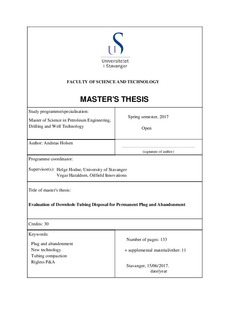| dc.contributor.advisor | Hodne, Helge | |
| dc.contributor.author | Holsen, Andreas | |
| dc.coverage.spatial | Norway, Stavanger | nb_NO |
| dc.date.accessioned | 2017-09-08T07:37:18Z | |
| dc.date.available | 2017-09-08T07:37:18Z | |
| dc.date.issued | 2017-06-15 | |
| dc.identifier.uri | http://hdl.handle.net/11250/2453670 | |
| dc.description | Master's thesis in Petroleum engineering | nb_NO |
| dc.description.abstract | A new method called Downhole Tubing Disposal developed by Oilfield Innovations for performing rigless permanent plug and abandonment is presented. Instead of pulling the production tubing, the tubing is weakened with longitudinal cuts which enables crushing of the tubing into the available liquid space of the constraining casing, effectively providing an unobstructed casing length where cement plugs can be set. By eliminating the requirement for a drilling rig, significant cost savings can be achieved. Evaluation of a full-scale experiment with a 2 3/8” tubing is given, and the plans for conducting a full-scale experiment with 4 ½” tubing is presented and discussed. Furthermore, a small-scale experiment was performed with the main objective being investigation of the influence of cutting pattern and radial clearance between compaction tube and constraint. The discussions from the three experiments are combined and further developed in terms of a real case of Downhole Tubing Disposal.
No studies on chaotic crushing of constrained tubes have been found in the literature except for an experiment conducted by the inventors of Downhole Tubing Disposal. The data on the matter were therefore limited, which motivated the small-scale experiment. This experiment clearly shows that weakening a tube with longitudinal cuts reduces its axial compressive strength, and an increasing number of cuts further reduces this strength. Moreover, the compaction ratio increased significantly at moderate loads when more than two cuts were used. Calculations revealed that while a smaller constraining tube gave a reduced compaction ratio, the occupied cross-sectional area of the constraining tube increased at high loads. At moderate loads, the occupied cross-sectional area was identical for the different constraining tubes. | nb_NO |
| dc.language.iso | eng | nb_NO |
| dc.publisher | University of Stavanger, Norway | nb_NO |
| dc.relation.ispartofseries | Masteroppgave/UIS-TN-IPT/2017; | |
| dc.rights | Navngivelse 4.0 Internasjonal | * |
| dc.rights.uri | http://creativecommons.org/licenses/by/4.0/deed.no | * |
| dc.subject | petroleum engineering | nb_NO |
| dc.subject | petroleumsteknologi | nb_NO |
| dc.subject | boreteknologi | nb_NO |
| dc.subject | new technology | nb_NO |
| dc.subject | tubing compaction | nb_NO |
| dc.subject | rigless plug and abandonment | nb_NO |
| dc.title | Evaluation of Downhole Tubing Disposal for Permanent Plug and Abandonment | nb_NO |
| dc.type | Master thesis | nb_NO |
| dc.subject.nsi | VDP::Technology: 500::Rock and petroleum disciplines: 510::Petroleum engineering: 512 | nb_NO |

